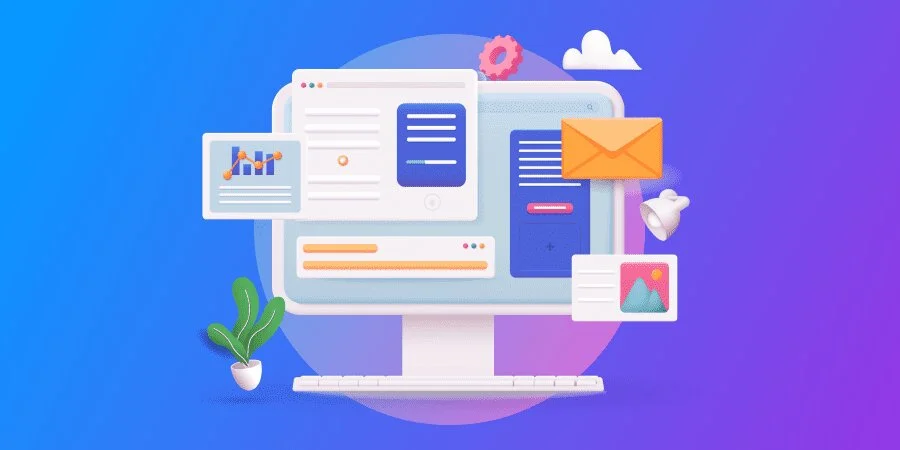Congratulations! You’ve conquered the competition and landed a new web design client.
It’s an exciting time for any designer, as your creative juices are probably buzzing with new ideas and fresh inspiration. However, this can also be a tricky moment.
It’s easy, as designers, to let your creativity flow as you get carried along by the design process. But without taking the time to gain a solid understanding of your client’s business, audience, and goals, you could end up producing a website that’s a work of art to look at but utterly useless in terms of their business aims and objectives.

If you want to wow your client with a website that looks gorgeous and meets their and their customers’ requirements, you need to ask a few well-designed questions before you dive into the fun stuff.
Here are nine crucial questions to ask your clients at the start of any web design project:
1. Describe your business in a few sentences
In other words, give us your best elevator pitch.

In some cases, your client’s business may appear blindingly obvious, but you should never assume anything. Ask them to sum up their business in a few short sentences; this is the essence that needs to be immediately obvious when visitors land on their new website.
Dig deeper, too. Try to find out what their key values are, their level of experience in the industry, and their vision of the future, as well as their size, location, and background.
2. Do you currently have a website? If so, what is/isn’t working for you?

Unless you’re starting from scratch, your client’s current website is a mine of information. Find out what CMS they use, how long they’ve had it, and how easy it is to update. What do they like and what can’t they wait to see the back of? Can they provide you with a Google Analytics report?
By spending some time reviewing the current website, you can learn more about your client’s likes and dislikes, as well as learn from any mistakes they made last time around.
3. What are your goals for this project?

I figured we were overdue a refresh – this site looks old and dated alongside our competitors.
This is a line often trotted out by clients. While it’s undoubtedly true, you need to know a bit more so you can produce a site that’s truly effective. At this point, you should take a step back and use your expertise to tease out your client’s motivations.
Ask for your client’s definition of success. Do they want to increase the amount of visitors, up the average order size, or boost the users on their web forum? Perhaps they want to encourage greater engagement via their blog, increase their brand visibility, or encourage people to sign up for their email newsletter/free trial/white paper, etc.
By establishing your client’s pain points and determining the issues they’re trying to solve, you stand a better chance of producing an efficient solution.
4. Who is your target audience?

Design is subjective and beauty is very much in the eye of the beholder. You’re not designing this website purely for your client. It has to resonate strongly with their users and target audience, otherwise, they simply won’t use it – online audiences are incredibly fickle today, owing to the hugely competitive market.
Delve into their user demographics and psychographics, such as their media consumption habits, slang words, and lifestyle choices. What are their purchasing habits? Do you need to bridge a gap between the current audience and target market? The more you know about the end users, the better you can determine the appearance, layout, and navigation of the website.
5. What specific features do you want on the site?

Establish at the outset whether your client has any particular functionalities they want included on their new website. Some things may be obvious. If your client runs a restaurant for example, they’ll need their opening hours and menu included, whereas if they run a hotel, they may want an online booking form.
Other possibilities include a blog, website chat, social media integration, photo galleries, a separate mobile or responsive site, video integration, or a contact form. Always clarify at the outset to avoid late additions that could cost time and money to marry into the site.
This is also the point to ask whether your client has any branding materials or style guides that need to be incorporated into the site’s design.
6. How can we avoid failure?

Knowing your client’s dislikes is equally important. Removing something integrated in a website once you’re halfway through a project is just as annoying, expensive and time-consuming as adding something in.
Ask them to show you their least favorite websites and point out the design elements, features, and styles that make them shudder. This way, you can strike out potential failures before you get into the nitty-gritty of the project.
7. Who are your main competitors?

Discovering your client’s main competitors provides you with another useful source of information. Once they’ve indicated their main rivals, you can gather information that will help guide your web design. Look at the elements that work well on their sites, and see if there are things that fall flat. Your intention here isn’t to copy what’s been done before, but to learn from their successes and failures. Asking your client to point out the things they do and don’t like on their competitors’ websites is another useful indicator of your client’s likes and dislikes.
8. What makes you different from your competitors?

Knowing your client’s unique selling point will help you design a site that stands apart from their competitors’. In the busy, noisy, competitive online world, businesses need to be truly remarkable to be successful. So how can you grab people’s attention when they land on the site? How can you make that tricky first impression count?
This doesn’t have to be anything major; it can be as simple as a free consultation or awesome customer service. Other things that make businesses stand out include speedy or free delivery on products, stocking the cheapest or best quality products in their area, having an amazing guarantee or returns procedure, or offering unique packages. By learning how your client differs from their competitors, you can deliver a site that does the same.
9. What’s the scope of the project?

Finally, clarify the scope of the project. You need a clear understanding of your client’s final deadline as well as any key milestones they want to meet along the way – this is crucial to keeping the project on track and ensuring you live up to expectations. You also need to know the budget and, more importantly, establish whether there’s any flexibility in the timeline and budget.
This is also the time to clarify who your main contacts are for the project, as well as who is providing the web content so you can establish clear lines of communication.
Do you still have questions about what WordPress is or whether it’s right for you? Ask us in the comments!